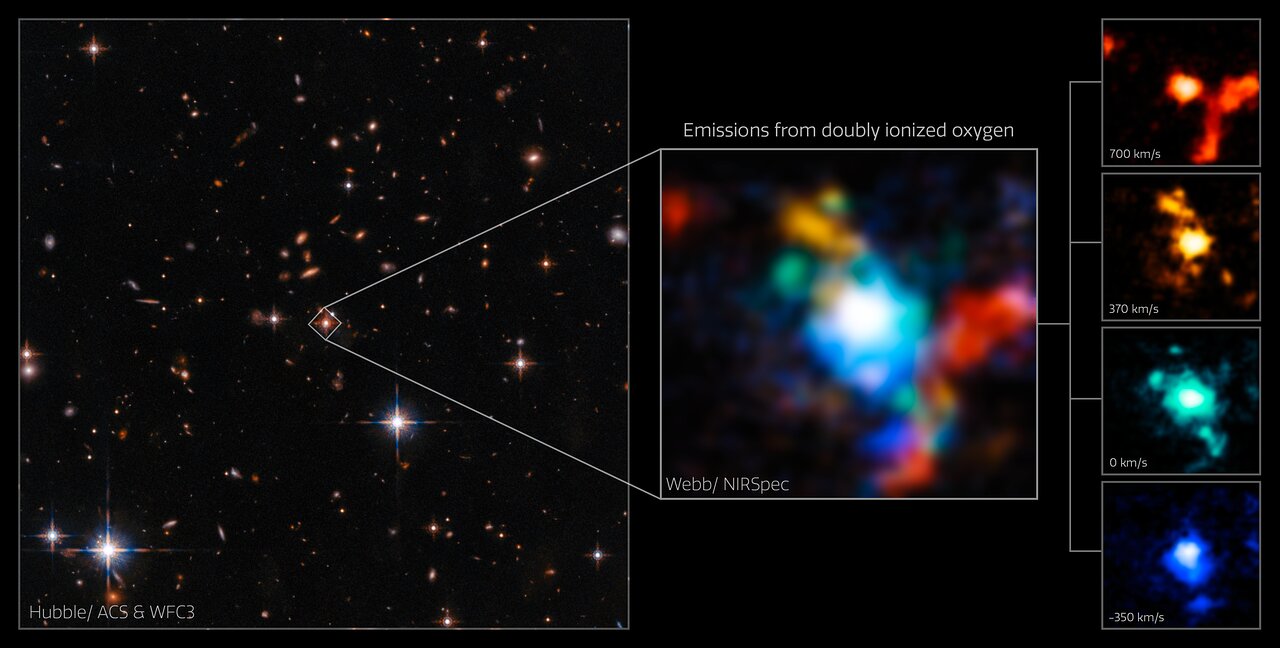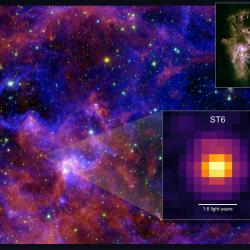James Webb Space Telescope Uncovers Massive Galaxy Cluster Surrounding a Powerful Red Quasar
UMD astronomer Sylvain Veilleux served as co-principal investigator of this latest glimpse into the early universe
Astronomers peering into the early Universe have made a surprising new discovery thanks to the world’s most powerful space telescope. The James Webb Space Telescope’s spectroscopic capabilities, combined with its infrared sensitivity, enabled scientists to find a cluster of massive galaxies in the process of forming around an extremely red quasar. The result will expand the scientific community’s understanding of how galaxies in the early Universe coalesced into the cosmic web seen today.
The object in question is an “extremely red” quasar that exists in the early Universe, 11.5 billion years ago. Quasars are a rare, incredibly luminous type of active galactic nucleus (AGN)—a term that describes a compact region at the center of a galaxy that emits enough electromagnetic radiation to outshine all the galaxy’s stars. This quasar is one of the most powerful known galactic nuclei that’s been seen at such an extreme distance. Astronomers had speculated that the quasar’s extreme emission could cause a “galactic wind,” pushing free gas out of its host galaxy and possibly greatly influencing future star formation there.
University of Maryland Astronomy Professor Sylvain Veilleux served as co-principal investigator of this latest study, which will be published in The Astrophysical Journal Letters.
“We are witnessing the formation of a massive cluster of galaxies—with a mass nearly a hundred times that of our own Milky Way galaxy—only 2.5 billion years after the Big Bang,” Veilleux said. “There are very few, if any, cases like this where structure formation on such a massive scale has been confirmed kinematically, or by using the velocities of the galaxies.”

AGNs, including quasars, are powered by gas falling into a supermassive black hole at the center of their galaxy. They typically emit vast amounts of light across all wavelengths, but this galactic core is a member of an unusually red class. In addition to its intrinsic red color, the galaxy’s light has been further “redshifted”—or moved into the red end of the spectrum, indicating an increase in wavelength—by its vast distance. That made Webb, with its unparalleled sensitivity to infrared wavelengths, perfectly suited to examine the galaxy in detail.
To investigate the movement of the gas, dust and stellar material in the galaxy, the research team used Webb’s Near Infrared Spectrograph (NIRSpec). This powerful instrument can gather spectra across the telescope’s central field of view at once—rather than capturing readings point by point—using a technique known as integral field unit (IFU) spectroscopy. This enabled researchers to simultaneously examine the quasar, its galaxy and the wider surroundings.
Spectroscopy helped researchers understand the movement of the various outflows and winds surrounding the quasar. The motions of the gases affect the light that they emit, causing it to be redshifted (due to positive velocities) or blueshifted (due to negative velocities) in proportion to their speed and direction. The team was able to see and characterize this movement by tracking ionized oxygen in the NIRSpec spectra. The IFU observations gave researchers the ability to collect spectra from a wide area around the quasar itself.
Because previous studies by the Hubble Space Telescope, Gemini North Telescope and others called attention to the quasar’s powerful outflows and environment, astronomers had speculated that its host galaxy could be merging with some unseen partner. But they were not expecting Webb’s NIRSpec data to clearly indicate that they were not just looking at one galaxy, but at least three more swirling around it.
“We selected a red quasar for this study because these quasars are known to have some of the fastest outflows on small scales,” Veilleux said. “The primary goal of our project was to spatially map the outflowing gas and get the outflow mass and energetics. The discovery of this protocluster [of galaxies] around the quasar was an unexpected bonus.”
Thanks to the IFU spectra over a broad area, the motions of all this surrounding material could be mapped, resulting in the conclusion that the quasar in question was in fact part of a dense knot of galaxy formation that could be home to billions of planets.
“There are few galaxy protoclusters known at this early time. It’s hard to find them, and very few have had time to form since the Big Bang,” said astronomer Dominika Wylezalek, of Heidelberg University in Germany, who led the study into this quasar. “This may eventually help us understand how galaxies in dense environments evolve … It’s an exciting result.”
Archive data from Hubble hints that there may be even more galactic companions. Images from Hubble’s Wide Field Camera 3 had shown extended material surrounding the quasar and its galaxy, prompting its selection for this study into its outflow and the effects on its host galaxy. Now, the team suspects they could have been looking at the core of a whole cluster of galaxies—only now revealed by Webb’s imaging.
"Our first look at the data quickly revealed clear signs of major interactions between the neighboring galaxies,” said researcher Andrey Vayner of Johns Hopkins University. “The sensitivity of the NIRSpec instrument was immediately apparent, and it was clear to me that we are in a new era of infrared spectroscopy."
The three confirmed galaxies are orbiting each other at incredibly high speeds, indicating that a great deal of mass is present. When combined with how closely they are packed into the region around this quasar, the team believes this marks one of the densest known areas of galaxy formation in the early Universe.
“Even a dense knot of dark matter isn’t sufficient to explain it,” Wylezalek says. “We think we could be seeing a region where two massive halos of dark matter are merging together.”
The team is planning follow-up observations into this unexpected galaxy protocluster, and hope to use it to understand how dense, chaotic galaxy clusters like this one form, and how it’s affected by the active, supermassive black hole at its heart. The present observations are just the first in a set which will study three quasars with Webb, each at different points in the Universe’s past.
“To disentangle the incredibly bright light of a distant quasar from the much dimmer host and its companions is almost impossible from the ground,” said researcher David Rupke of Rhodes College. “Uncovering the details of the galactic winds that may produce feedback is even more challenging. Now with Webb, we can already see that’s changing.”
This research was completed as part of Webb’s Early Release Science (ERS) Programs. It is also one small part of Webb’s investigations into the early Universe. With its unprecedented ability to look back in time, the telescope is already being used to investigate how the first galaxies formed and evolved, and how black holes formed and influenced the structure of the Universe. In August, it detected the first evidence of carbon dioxide in an exoplanet’s atmosphere—a finding that UMD astronomers Eliza Kempton and Thaddeus Komacek contributed to.
###
This article is adapted from text provided by the European Space Agency.
In addition to Veilleux, Weizhe Liu (M.S. ’18, Ph.D. ’22, astronomy) also contributed to this research.







